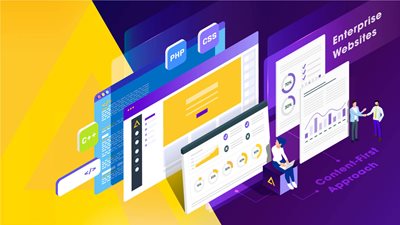The 10 Best Content Management Tools for Content Marketing Teams
Find the best content management tools on the market!


A common challenge content marketers face when choosing content management tools is a lack of buy-in from management to invest in a robust tech stack to help with content management.
One way to overcome this is to be clear about the content management challenges you’re facing to help you identify the kind of tool you need and then demonstrate the value you’re going to get from the tool.
Are you looking for a better way to store your digital assets, improve your workflow to maintain content quality, or improve collaboration within your content team to keep up with publishing schedules?
The benefits of having an answer to these questions are twofold. First, you’re going to narrow down the list of tools you need so you won’t have to get stuck because you’re spoilt for choice.
Secondly, you’ll have an easier time justifying the business impact of the tool you pick.
What are content management tools?
Content management tools are software tools that bring together your content projects, workflows, and your team to implement your content marketing strategy.
Content management tools help you align the content you create and publish with business priorities.
They also streamline your entire content lifecycle, right from ideation to maintenance to help you maintain content quality, making it easier for you to link your content to business objectives.
There are different types of content management tools:
1. Content calendar tools
A content calendar tool helps you manage and keep track of all your published and unpublished content assets. You can use a content calendar to create publishing timelines, tasks, set due dates, and specific milestones for each piece.
A content calendar tool also shows you who is working on what and makes it easier to collaborate with the team to maintain a consistent publishing schedule.
2. Workflow management tools
Workflow management tools help you make sure that everyone follows your content creation process. Your workflow should have a checklist to ensure that each piece of content you publish meets your content quality standards.
Using a workflow management tool, it's easier to identify unnecessary tasks or steps in the production workflow, identify bottlenecks, and optimize your workflow for speed and efficiency.
3. Digital Asset Management Tools
Digital asset management tools help you store and organize all your content assets in one place and make it easy for you to find them whenever you need them.
With a digital asset management tool, it's easier for you to determine who has access to different content assets for improved privacy and security and share them with internal and external collaborators efficiently.
4. Headless Content Management Systems
A headless CMS is entirely decoupled from the presentation layer/frontend, which in this case is the “head”, and the backend is your content repository, known as the “body”.
A typical week for content teams isn’t immune to managemental challenges. It could be failing to meet content requests from different departments on time, missing a publishing schedule or two, and having to look for different content assets that you can’t seem to locate.
And when you’re scaling your content strategy, you’ll need to solve these challenges by using tools that help you streamline your content management so you can focus on tracking and optimizing content performance to help you hit your content marketing KPIs.
The 10 Best Content managements Tools for Content Marketing Teams
- Agility CMS
- Jasper.ai
- Smartling
- Coschedule
- StoryChief
- GatherContent
- Monday.com
- Canto
- Airtable
- Narrato
1. Improve your Content Marketing team’s Workflow with Agility CMS
Agility CMS is a powerful and flexible headless CMS with a wide range of features, to help content teams manage their workflows, content, and digital assets, to improve collaboration.
Agility CMS has a modular design that allows you to create custom content models to fit the different types of content you create.
As a content management tool, Agility CMS helps you create content and publish it on multiple channels like social media, blogs or newsletters at the same time.
When using Agility CMS to approve content, choose the content that needs to be approved before publishing and a checklist to use when approving the content.
There are three roles inside Agility, namely editor, publisher, and manager. Assign approval roles such as editing and publishing content, and choose who does what to make sure everyone knows their roles.
For digital asset management, Agility CMS comes with a centralized repository for all your files, from images to video, and an intuitive user interface to help you organize and find your assets with ease.
2. Jasper.ai
AI-generated content shouldn’t be a replacement for your team of writers and subject matter experts. However, having an AI tool like Jasper.ai in your content management's tech stack will help you get unstuck, especially when you’re dealing with writer’s block.
If you’re wondering where Jasper would fit into your workflow, take a look at Jasper’s integration with SurferSEO, a content optimization tool.
When working with writers to scale the amount of content you’re publishing, you will need to send them briefs for each piece with a simplified outline to guide them on how to proceed with creating the content.
Creating these briefs will take time, and you may not have the luxury of starting from scratch each time, creating a brief.
Use Jasper’s blog post recipes (which you can customize) to create a brief and an outline that writers can use. The tool's AI engine will generate relevant, personalized content based on your goals and target audience.
Jasper has two pricing plans: Starter ($29/month), and Boss Mode ($99/month). Jasper offers a five-day free trial that comes with a money-back guarantee, so if you’re not satisfied with the content you receive, you can opt-out as soon as possible.
3. Smartling
For content teams entering into new markets where they need to publish their content in the local language, Smartling not only offers translation services but also integrates with CMS tools such as Contentful, SiteCore, and Adobe Experience Manager.
The integration helps you plan your workflow to include translation without having to move back and forth between tools to find your translated content or even transfer content that you need to translate.
For your translation projects, Smartling also allows you to manage all your translations in a single place to help streamline your workflow.
The intuitive user interface provides you with the information you need about your translation project and you can customize it to fit your needs, based on the information you need to see every time you log in.
The translation isn’t about converting your content into a different language. For your translated content to be effective, the translation needs to capture the different nuances, and subtle meanings of words in different languages and maintain the tone and voice of your brand.
For this reason, Smartling provides you with transcreation, a feature that helps to maintain the meaning and context of your translated content. You no longer have to use spreadsheets to keep track of different phrases, their translations, and what they mean in the local language.
Smartling also comes with an analytics feature that provides you with data about the quality of your translations and the efficiency of your translation workflow. You also get suggestions on what you need to do to optimize your workflow and reduce costs.
Pricing: Smartling comes with two pricing plans: Growth and Enterprise. You pay for what you translate and you get discounts the more you use the tool. Talk to the sales team for a quote.
4. Form automation software: Formstack
With Formstack's user-friendly interface, you can create custom online forms with conditional logic to automate your workflows and streamline your approval process and the flow of data across your teams and organizations.
A Formstack integration with Agility CMS will retrieve the list of forms you've created in Formstack so you can easily embed them within your Agility-powered website or application.
5. Marketing automation Integration: Hubspot and Agility CMS
HubSpot is a powerful and easy-to-use platform for marketing, sales, customer service, and CRM software. Easily collect data from fillable forms on your Agility CMS-powered website to learn more and connect with your customers.

6. Coschedule
Coschedule allows you to manage all your marketing activities in one place, right from ideation to social promotion.
As a content management tool, it comes with a marketing calendar feature to help you visualize all your marketing activities so you can easily coordinate everything and keep track of your content publishing schedule.
Create a content calendar for the different types of content you’re creating and assign color codes depending on the team member, content type, theme, channel, or even campaign type.
For all your recurring content production tasks, save time by creating a template with a to-do list and using it to streamline your workflow.
Depending on the complexity of the task and the number of people involved in a particular project, CoSchedule allows you to create different automation so that the task moves to the next stage once a team member completes the to-do list.
Use the filters to narrow down your views to specific tasks, to what you’re looking for to help you get the information you need.
There’s also a read-only view, and you can copy and share a link of your marketing calendar with outside contributors instead of paying for more seats or even grabbing screenshots and sharing them. ending them to them.
Coschedule also helps you manage your digital assets, making it easy to find and share brand guidelines, and content templates with your team members.
The asset organizer allows you to create a library of all your digital assets, customize asset labels to make it easy to find them, and share assets securely with external contributors.
Pricing: Coschedule comes with three pricing plans: Free, Pro ($29/month), and Business (talk to an expert)
7. StoryChief
StoryChief helps content teams collaborate on content creation and helps them promote their content to different marketing channels, all in one place. And if the content creation process leaves you too exhausted to think about promotion, then consider using StoryChief.
Start by creating a campaign inside Storychief that will guide your activities inside the platform. The campaign feature allows you to create start and end dates, and KPIs, add information about your ideal customer profile, and add contributors.
Once you’re done, add your content topics to the editorial calendar and invite your team of writers to use Storychief’s blogging platform.
The blogging platform allows you to streamline the content approval process by reviewing outlines and drafts from writers and providing feedback in the same place, meaning that you work faster without unnecessary delays.
StoryChief has a media library that allows you to save both videos and images that you use in your content. Having all the visual assets you need for content creation in one place saves you time.
Like any other content editor, writers can format content and add images and add videos to your content, without leaving the platform.
StoryChief weaves content creation and promotion by allowing you to connect to your social media accounts and track the reach and performance of your content.
Pricing: StoryChief has four pricing plans: Team ($100/month), Team Plus ($180/month), Agency ($350/month), and Enterprise (talk to the sales team for a quote).
8. GatherContent
Instead of moving back and forth between different content tools you’re using to manage your content team, GatherContent helps you run all your management in one place, so your team has what they need when they need it.
For example, assume you just hired writers and you need to make sure they’re familiar with your style guide and use your content templates to speed up content creation. The old way would have you sending different documents to each writer.
Using GatherContent to run your content management, all you have to do is provide all the documents they need inside the content editor and let them work inside the tool.
You do not have to keep checking whether everyone has access to everything they need before they start writing.
If you’re working with different clients or creating different content assets, GatherContent also allows you to create your content calendar and customize your content workflows for each content asset, making sure that everyone is onboard.
To avoid overlap of roles or unnecessary friction, provide different access levels for your team members at each stage of the workflow so that clients, writers, designers, and subject matter experts know when and where they fit into the workflow.
In a recent announcement, Bynder, a digital asset management tool, acquired GatherContent.
Content management and digital asset management tend to work in isolation, making it hard to store, organize, find, and share your digital assets. Bynder’s acquisition removes this bottleneck since both platforms have come together to improve content management.
Pricing: In addition to their 14-day free trial, GatherContent has three pricing plans: Starter ($299/month), Advanced ($799/month), and Custom (talk to the sales team for a quote).
9. Monday.com
Monday.com is a project management software tool ideal for large content teams with large content projects that use agile principles to manage their content projects.
As a content management tool, Monday.com allows you to collaborate with your team to manage projects, tasks, and conversations in one place.
Monday.com helps you organize your content calendar and prioritize tasks by providing you with an overview of your day and week. It also allows you to track time to help you know how much time it takes to publish content.
If you notice that the approval process is a bottleneck, use the different automation Monday.com provides to help you get rid of repeatable tasks:
Use Kanban boards for visualizing your content and project workflows and the Gantt chart view to plan and visualize tasks. It also has a team chat to communicate with your team members.
Monday.com also allows you to store all your digital assets in one place, making it easier for you to organize, find and share them with your team members on relevant projects.
When creating tasks, attach relevant assets that your team member might need to use, for example, featured blog images and screenshots of your product.
You can use it on any device, which means you can work from anywhere using the built-in chatbot called ‘Monday Bot. The chatbot helps you manage your tasks and projects from Slack by providing you with updates on your tasks and projects at regular intervals so that you don't miss anything important.
Pricing: Monday.com comes with five pricing plans based on the number of seats you intend to use: Individual (Free forever), Basic ($8 per seat per month), Standard ($10 per seat per month), Pro ($16 per seat per month), and Enterprise (talk to the sales team for a quote).
10. Canto
Canto is a digital asset management tool that simplifies the management of your digital assets by making it easy to label, organize, and sort different folders and files. The smart albums feature identifies different file types you upload and places them in relevant folders.
As a standalone digital asset management tool, Canto stands out as a critical asset in content management by integrating with social media platforms such as Facebook, LinkedIn, Vimeo, Youtube, and Twitter. So if you’re looking to share your digital assets right from Canto to social media, just connect to the platforms you use and share your assets.
When looking for digital assets to share, use the easy, advanced, and filter options to help you quickly find what you are looking for.
If you’re looking for visual assets, Canto has a facial recognition feature that helps you find different videos and images that have images of the person you’re looking for. This feature comes in handy when you’re looking for different assets in your library and you can’t recall where each asset is located.
To improve collaboration, Canto integrates with Slack and Microsoft teams to help you seamlessly share your assets with the team. Set a limit on the number of files users can download, and set rules and permissions, which determine what different users can and can’t do with your data assets.
For example, an administrator might be the only one allowed to delete files, and consumers can't do anything without the approval of the administrator or contributor.
It also has a mobile app, so you can access your assets from wherever you are. When working with different collaborators, you don’t need to give them access to your assets.
Pricing: To find out about Canto’s pricing, you either have to fill out a form or book a meeting. The tool comes with a free trial to help you decide if you want to use it as a digital asset management tool.
11. Airtable
Airtable is a simple database tool that has spreadsheet capabilities, ideal for content managers who rely on Microsoft Excel and Google Sheets to create editorial calendars and manage writers.
Airtable is highly customizable and it allows you to create different records, manage your data, and keep track of, and reference every activity in your content calendar.
To get started, Airtable comes with templates to help you run your content management. The Content Calendar Template has come with three tables: Content Pipeline, Campaigns, and Results.
So, when setting up your content management, start with the campaigns table and create the different campaigns you’ll be running.
For example, you might want to run a campaign where your goal is to create pillar content around a certain keyword and clusters to help you rank highly on the SERP.
So, create the campaign and add all the details you’ll need. Once you’re done, head over to the content pipeline table and where you’ll add the different topics, add relevant assets, and any other relevant information your writers need to start creating content.
Unlike Microsoft Excel and Google Sheets, where you have to move back and forth to check the details in each table, Airtable allows you to link records from different tables. In this case, you’ll see your content campaign and results right from the content pipeline:
Customize your views by choosing from different options such as grid, calendar, Kanban, and Gantt to visualize your calendar according to your preferences.
Pricing: In addition to a free trial, Airtable has four pricing plans: Free, Plus ($10/month), Pro ($20/month), and Enterprise (talk to the sales team for a custom quote).
12. Narrato
Narrato is content creation, collaboration, and workflow management platform that brings the entire content process to one place.
It replaces the multiple tools that emerging businesses often use for their content management, like docs, sheets, project management software, email, messaging apps, and more.
Narrato has a powerful content editor and some amazing collaboration features that let your team easily create content and share feedback. Project management tools on the platform help track your content projects.
There are custom roles and access for team members, freelancers, and other users. All your content can be neatly organized and stored on the platform as well.
Pricing: Free plan for teams just getting started. Paid plans start at $8 per user per month.
Conclusion
To succeed in content management, you don’t need more tools. You need to be intentional about identifying the challenges you’re facing when it comes to streamlining your workflows, keeping up with your publishing schedule, and managing your team.
Looking at your existing content management, what would you identify as the biggest challenge, that is preventing you from getting more out of the content you publish?
The tools we’ve discussed above would make a great addition to your existing tech stack, with a majority of the tools having workflow management, content calendar, and digital asset management capabilities.

About the Author
Agility CMS is Canada's original headless CMS platform. Since 2002, Agility has helped companies across Canada and around the world better manage their content. Marketers are free to create the content they want, when they want it. Developers are empowered to build what they want, how they want.
- Get a demo for a personalized walkthrough.
- Try for FREE and experience Agility CMS.
- Contact us with your questions.
View Related Resources

Agile Digital Content Strategy to Implement in 2022

How to Take a Content-First Approach for Enterprise Websites

User-Generated Content Strategy with a CMS To Drive Sales
Improve your marketing strategy with headless CMS
You've got a lot of options when it comes to choosing a CMS. Do you pick one that has the fast and flexible features of a headless platform, or one that features the familiar authoring tools that marketers know and love? With Agility, you don't have to choose.
Book a demo

